Comprehensive Report: Diversity Policy, Implementation, and Analysis
VerifiedAdded on 2021/10/09
|20
|5775
|136
Report
AI Summary
This report delves into the critical aspects of diversity policies within business operations. It addresses key problems arising from a lack of diversity, such as gender inequality, lack of respect, ethnic and social differences, and age-related issues. The report highlights the various advantages of a diverse workforce, including increased profitability, quicker problem resolution, enhanced innovativeness, and improved learning and development. It provides real-world examples of companies like AT&T, Adobe Systems, PayPal, and Intuit that have successfully implemented diversity initiatives. The report also explores the institutional and resource-based theories that support diversity implementation and outlines relevant legislation, codes of practice, and national standards. Furthermore, it includes a practical project section, presenting a diversity policy and action plan for a company called Soft-Authent, analyzing its current workforce demographics, and benchmarking against industry leaders. This comprehensive analysis provides valuable insights into the development and implementation of effective diversity policies.
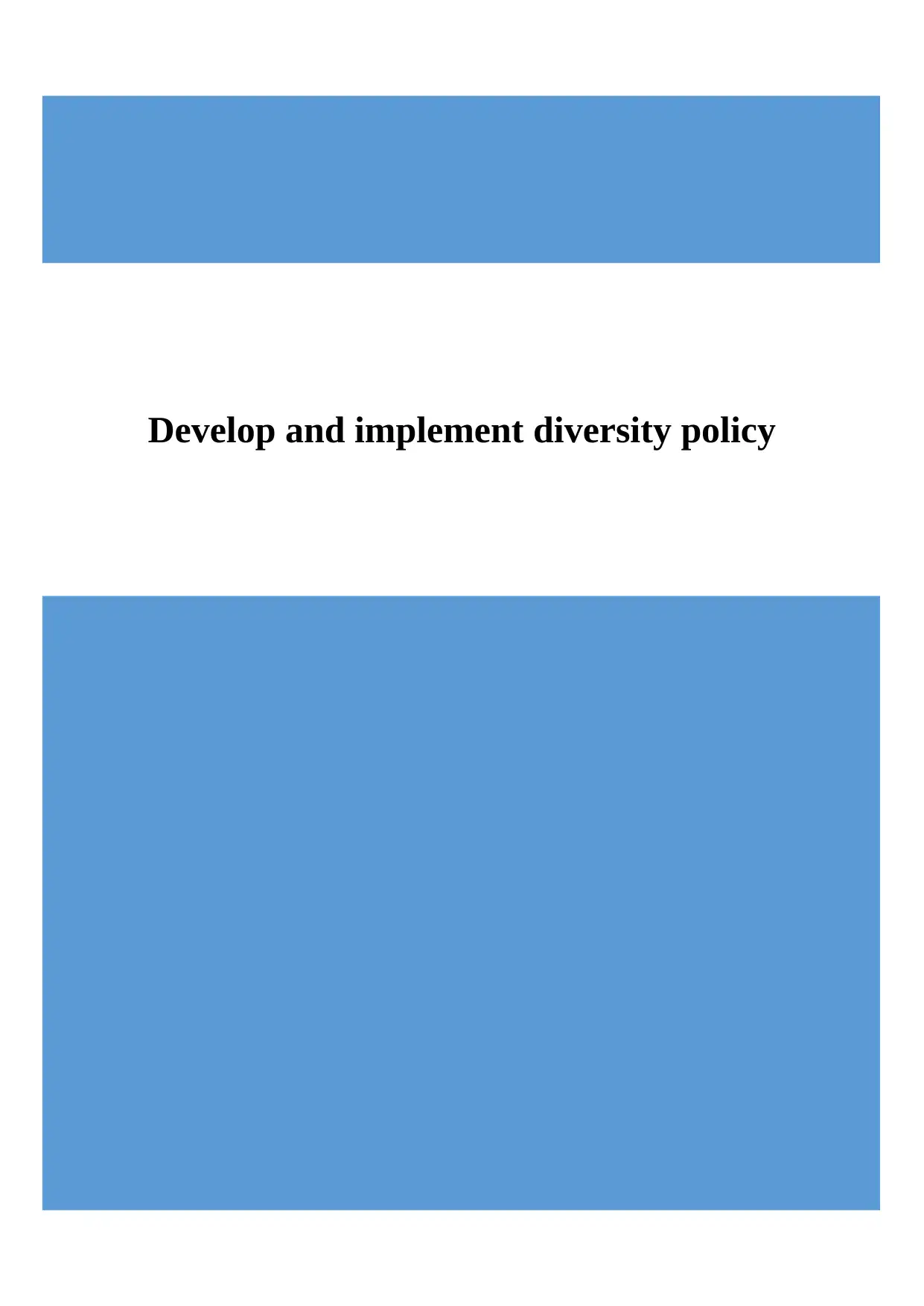
Develop and implement diversity policy
Paraphrase This Document
Need a fresh take? Get an instant paraphrase of this document with our AI Paraphraser
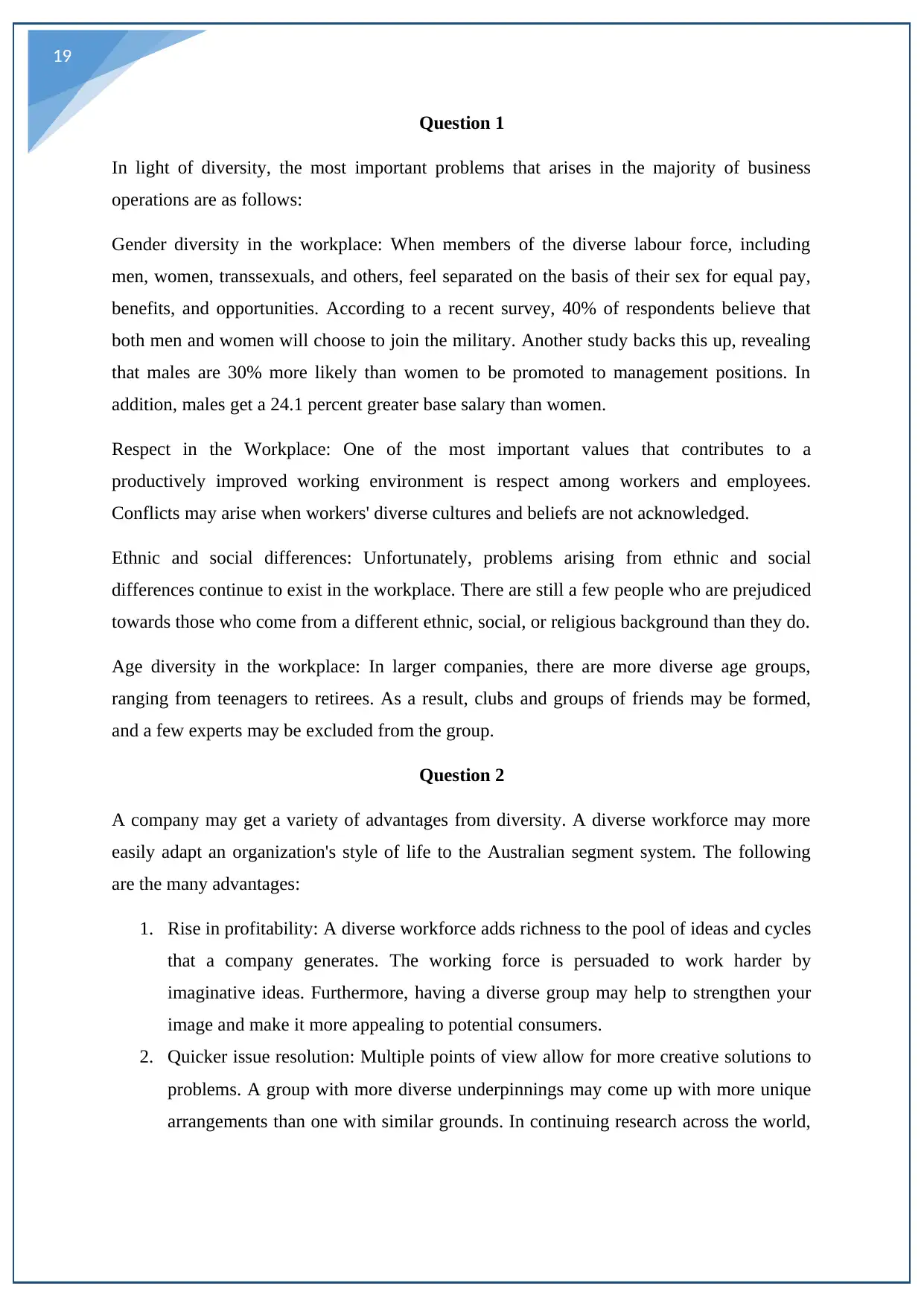
19
Question 1
In light of diversity, the most important problems that arises in the majority of business
operations are as follows:
Gender diversity in the workplace: When members of the diverse labour force, including
men, women, transsexuals, and others, feel separated on the basis of their sex for equal pay,
benefits, and opportunities. According to a recent survey, 40% of respondents believe that
both men and women will choose to join the military. Another study backs this up, revealing
that males are 30% more likely than women to be promoted to management positions. In
addition, males get a 24.1 percent greater base salary than women.
Respect in the Workplace: One of the most important values that contributes to a
productively improved working environment is respect among workers and employees.
Conflicts may arise when workers' diverse cultures and beliefs are not acknowledged.
Ethnic and social differences: Unfortunately, problems arising from ethnic and social
differences continue to exist in the workplace. There are still a few people who are prejudiced
towards those who come from a different ethnic, social, or religious background than they do.
Age diversity in the workplace: In larger companies, there are more diverse age groups,
ranging from teenagers to retirees. As a result, clubs and groups of friends may be formed,
and a few experts may be excluded from the group.
Question 2
A company may get a variety of advantages from diversity. A diverse workforce may more
easily adapt an organization's style of life to the Australian segment system. The following
are the many advantages:
1. Rise in profitability: A diverse workforce adds richness to the pool of ideas and cycles
that a company generates. The working force is persuaded to work harder by
imaginative ideas. Furthermore, having a diverse group may help to strengthen your
image and make it more appealing to potential consumers.
2. Quicker issue resolution: Multiple points of view allow for more creative solutions to
problems. A group with more diverse underpinnings may come up with more unique
arrangements than one with similar grounds. In continuing research across the world,
Question 1
In light of diversity, the most important problems that arises in the majority of business
operations are as follows:
Gender diversity in the workplace: When members of the diverse labour force, including
men, women, transsexuals, and others, feel separated on the basis of their sex for equal pay,
benefits, and opportunities. According to a recent survey, 40% of respondents believe that
both men and women will choose to join the military. Another study backs this up, revealing
that males are 30% more likely than women to be promoted to management positions. In
addition, males get a 24.1 percent greater base salary than women.
Respect in the Workplace: One of the most important values that contributes to a
productively improved working environment is respect among workers and employees.
Conflicts may arise when workers' diverse cultures and beliefs are not acknowledged.
Ethnic and social differences: Unfortunately, problems arising from ethnic and social
differences continue to exist in the workplace. There are still a few people who are prejudiced
towards those who come from a different ethnic, social, or religious background than they do.
Age diversity in the workplace: In larger companies, there are more diverse age groups,
ranging from teenagers to retirees. As a result, clubs and groups of friends may be formed,
and a few experts may be excluded from the group.
Question 2
A company may get a variety of advantages from diversity. A diverse workforce may more
easily adapt an organization's style of life to the Australian segment system. The following
are the many advantages:
1. Rise in profitability: A diverse workforce adds richness to the pool of ideas and cycles
that a company generates. The working force is persuaded to work harder by
imaginative ideas. Furthermore, having a diverse group may help to strengthen your
image and make it more appealing to potential consumers.
2. Quicker issue resolution: Multiple points of view allow for more creative solutions to
problems. A group with more diverse underpinnings may come up with more unique
arrangements than one with similar grounds. In continuing research across the world,
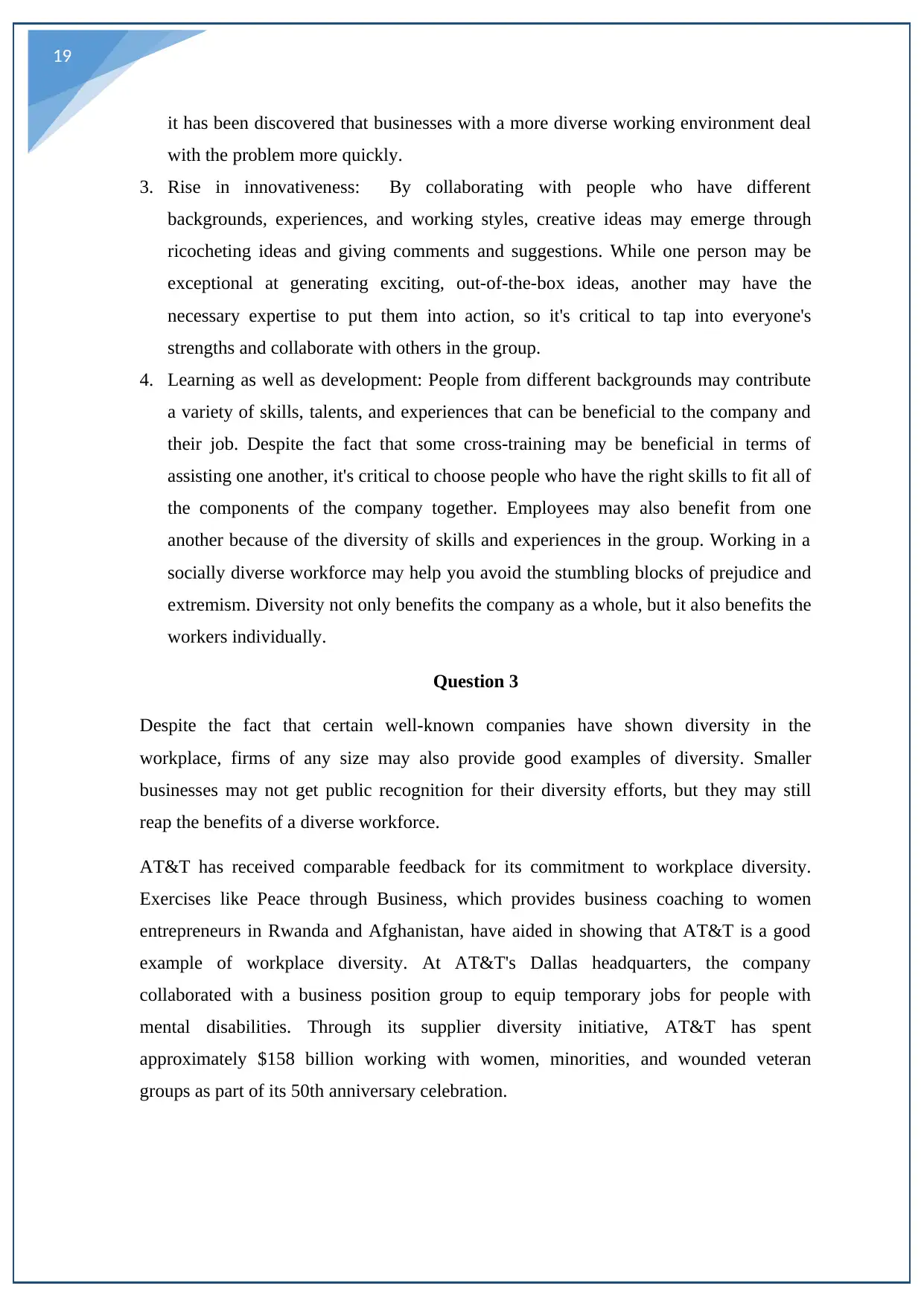
19
it has been discovered that businesses with a more diverse working environment deal
with the problem more quickly.
3. Rise in innovativeness: By collaborating with people who have different
backgrounds, experiences, and working styles, creative ideas may emerge through
ricocheting ideas and giving comments and suggestions. While one person may be
exceptional at generating exciting, out-of-the-box ideas, another may have the
necessary expertise to put them into action, so it's critical to tap into everyone's
strengths and collaborate with others in the group.
4. Learning as well as development: People from different backgrounds may contribute
a variety of skills, talents, and experiences that can be beneficial to the company and
their job. Despite the fact that some cross-training may be beneficial in terms of
assisting one another, it's critical to choose people who have the right skills to fit all of
the components of the company together. Employees may also benefit from one
another because of the diversity of skills and experiences in the group. Working in a
socially diverse workforce may help you avoid the stumbling blocks of prejudice and
extremism. Diversity not only benefits the company as a whole, but it also benefits the
workers individually.
Question 3
Despite the fact that certain well-known companies have shown diversity in the
workplace, firms of any size may also provide good examples of diversity. Smaller
businesses may not get public recognition for their diversity efforts, but they may still
reap the benefits of a diverse workforce.
AT&T has received comparable feedback for its commitment to workplace diversity.
Exercises like Peace through Business, which provides business coaching to women
entrepreneurs in Rwanda and Afghanistan, have aided in showing that AT&T is a good
example of workplace diversity. At AT&T's Dallas headquarters, the company
collaborated with a business position group to equip temporary jobs for people with
mental disabilities. Through its supplier diversity initiative, AT&T has spent
approximately $158 billion working with women, minorities, and wounded veteran
groups as part of its 50th anniversary celebration.
it has been discovered that businesses with a more diverse working environment deal
with the problem more quickly.
3. Rise in innovativeness: By collaborating with people who have different
backgrounds, experiences, and working styles, creative ideas may emerge through
ricocheting ideas and giving comments and suggestions. While one person may be
exceptional at generating exciting, out-of-the-box ideas, another may have the
necessary expertise to put them into action, so it's critical to tap into everyone's
strengths and collaborate with others in the group.
4. Learning as well as development: People from different backgrounds may contribute
a variety of skills, talents, and experiences that can be beneficial to the company and
their job. Despite the fact that some cross-training may be beneficial in terms of
assisting one another, it's critical to choose people who have the right skills to fit all of
the components of the company together. Employees may also benefit from one
another because of the diversity of skills and experiences in the group. Working in a
socially diverse workforce may help you avoid the stumbling blocks of prejudice and
extremism. Diversity not only benefits the company as a whole, but it also benefits the
workers individually.
Question 3
Despite the fact that certain well-known companies have shown diversity in the
workplace, firms of any size may also provide good examples of diversity. Smaller
businesses may not get public recognition for their diversity efforts, but they may still
reap the benefits of a diverse workforce.
AT&T has received comparable feedback for its commitment to workplace diversity.
Exercises like Peace through Business, which provides business coaching to women
entrepreneurs in Rwanda and Afghanistan, have aided in showing that AT&T is a good
example of workplace diversity. At AT&T's Dallas headquarters, the company
collaborated with a business position group to equip temporary jobs for people with
mental disabilities. Through its supplier diversity initiative, AT&T has spent
approximately $158 billion working with women, minorities, and wounded veteran
groups as part of its 50th anniversary celebration.
⊘ This is a preview!⊘
Do you want full access?
Subscribe today to unlock all pages.

Trusted by 1+ million students worldwide
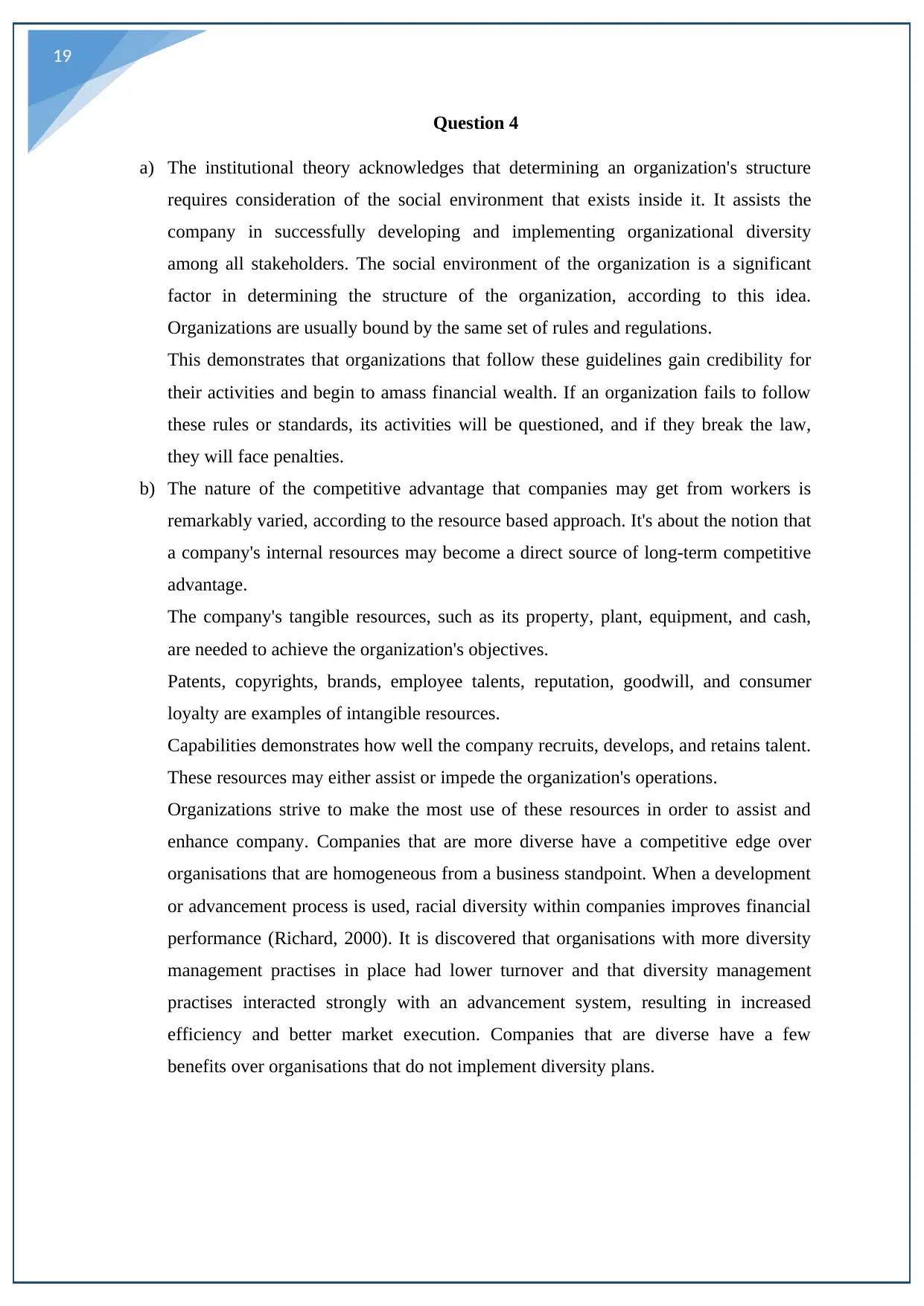
19
Question 4
a) The institutional theory acknowledges that determining an organization's structure
requires consideration of the social environment that exists inside it. It assists the
company in successfully developing and implementing organizational diversity
among all stakeholders. The social environment of the organization is a significant
factor in determining the structure of the organization, according to this idea.
Organizations are usually bound by the same set of rules and regulations.
This demonstrates that organizations that follow these guidelines gain credibility for
their activities and begin to amass financial wealth. If an organization fails to follow
these rules or standards, its activities will be questioned, and if they break the law,
they will face penalties.
b) The nature of the competitive advantage that companies may get from workers is
remarkably varied, according to the resource based approach. It's about the notion that
a company's internal resources may become a direct source of long-term competitive
advantage.
The company's tangible resources, such as its property, plant, equipment, and cash,
are needed to achieve the organization's objectives.
Patents, copyrights, brands, employee talents, reputation, goodwill, and consumer
loyalty are examples of intangible resources.
Capabilities demonstrates how well the company recruits, develops, and retains talent.
These resources may either assist or impede the organization's operations.
Organizations strive to make the most use of these resources in order to assist and
enhance company. Companies that are more diverse have a competitive edge over
organisations that are homogeneous from a business standpoint. When a development
or advancement process is used, racial diversity within companies improves financial
performance (Richard, 2000). It is discovered that organisations with more diversity
management practises in place had lower turnover and that diversity management
practises interacted strongly with an advancement system, resulting in increased
efficiency and better market execution. Companies that are diverse have a few
benefits over organisations that do not implement diversity plans.
Question 4
a) The institutional theory acknowledges that determining an organization's structure
requires consideration of the social environment that exists inside it. It assists the
company in successfully developing and implementing organizational diversity
among all stakeholders. The social environment of the organization is a significant
factor in determining the structure of the organization, according to this idea.
Organizations are usually bound by the same set of rules and regulations.
This demonstrates that organizations that follow these guidelines gain credibility for
their activities and begin to amass financial wealth. If an organization fails to follow
these rules or standards, its activities will be questioned, and if they break the law,
they will face penalties.
b) The nature of the competitive advantage that companies may get from workers is
remarkably varied, according to the resource based approach. It's about the notion that
a company's internal resources may become a direct source of long-term competitive
advantage.
The company's tangible resources, such as its property, plant, equipment, and cash,
are needed to achieve the organization's objectives.
Patents, copyrights, brands, employee talents, reputation, goodwill, and consumer
loyalty are examples of intangible resources.
Capabilities demonstrates how well the company recruits, develops, and retains talent.
These resources may either assist or impede the organization's operations.
Organizations strive to make the most use of these resources in order to assist and
enhance company. Companies that are more diverse have a competitive edge over
organisations that are homogeneous from a business standpoint. When a development
or advancement process is used, racial diversity within companies improves financial
performance (Richard, 2000). It is discovered that organisations with more diversity
management practises in place had lower turnover and that diversity management
practises interacted strongly with an advancement system, resulting in increased
efficiency and better market execution. Companies that are diverse have a few
benefits over organisations that do not implement diversity plans.
Paraphrase This Document
Need a fresh take? Get an instant paraphrase of this document with our AI Paraphraser
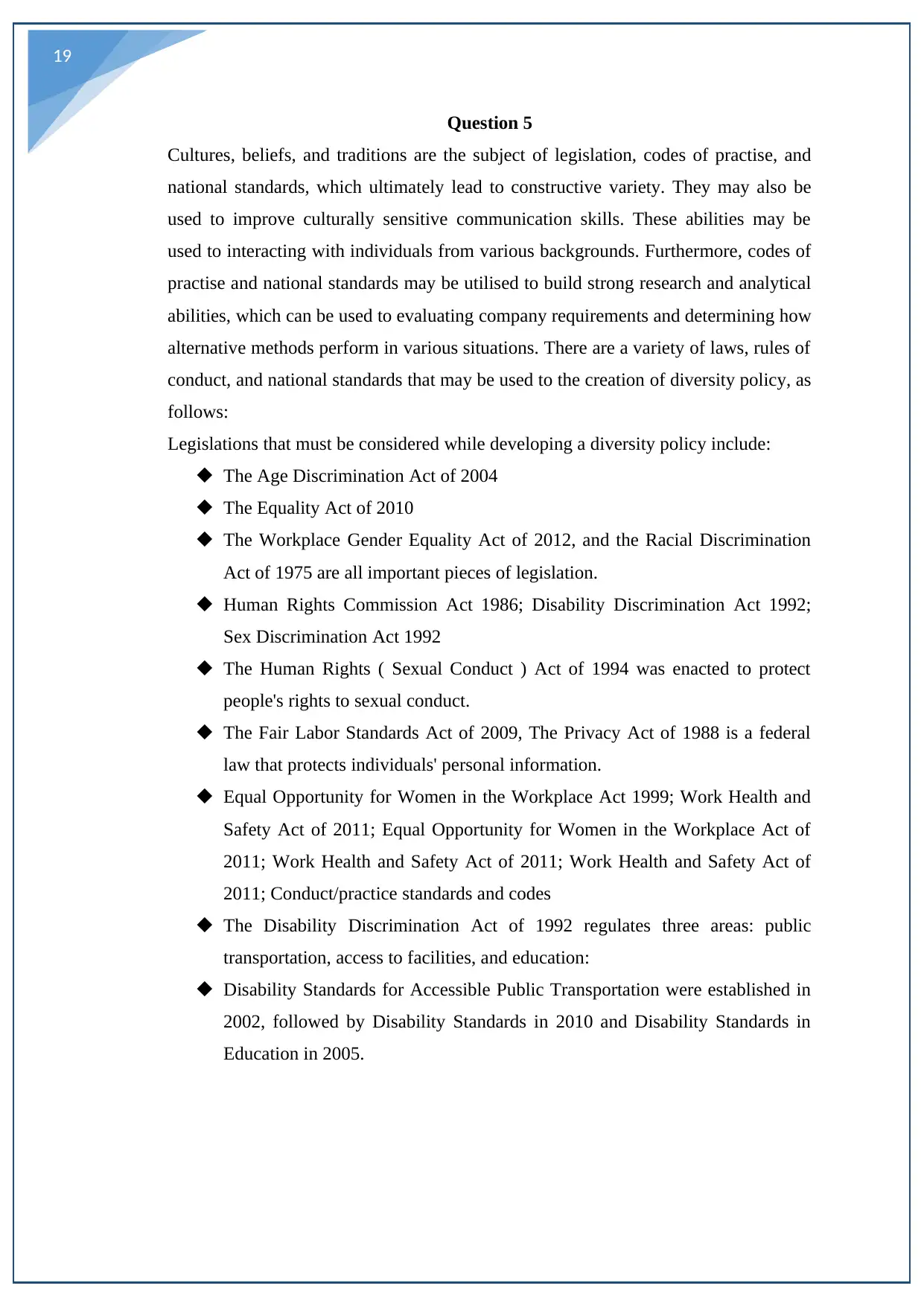
19
Question 5
Cultures, beliefs, and traditions are the subject of legislation, codes of practise, and
national standards, which ultimately lead to constructive variety. They may also be
used to improve culturally sensitive communication skills. These abilities may be
used to interacting with individuals from various backgrounds. Furthermore, codes of
practise and national standards may be utilised to build strong research and analytical
abilities, which can be used to evaluating company requirements and determining how
alternative methods perform in various situations. There are a variety of laws, rules of
conduct, and national standards that may be used to the creation of diversity policy, as
follows:
Legislations that must be considered while developing a diversity policy include:
The Age Discrimination Act of 2004
The Equality Act of 2010
The Workplace Gender Equality Act of 2012, and the Racial Discrimination
Act of 1975 are all important pieces of legislation.
Human Rights Commission Act 1986; Disability Discrimination Act 1992;
Sex Discrimination Act 1992
The Human Rights ( Sexual Conduct ) Act of 1994 was enacted to protect
people's rights to sexual conduct.
The Fair Labor Standards Act of 2009, The Privacy Act of 1988 is a federal
law that protects individuals' personal information.
Equal Opportunity for Women in the Workplace Act 1999; Work Health and
Safety Act of 2011; Equal Opportunity for Women in the Workplace Act of
2011; Work Health and Safety Act of 2011; Work Health and Safety Act of
2011; Conduct/practice standards and codes
The Disability Discrimination Act of 1992 regulates three areas: public
transportation, access to facilities, and education:
Disability Standards for Accessible Public Transportation were established in
2002, followed by Disability Standards in 2010 and Disability Standards in
Education in 2005.
Question 5
Cultures, beliefs, and traditions are the subject of legislation, codes of practise, and
national standards, which ultimately lead to constructive variety. They may also be
used to improve culturally sensitive communication skills. These abilities may be
used to interacting with individuals from various backgrounds. Furthermore, codes of
practise and national standards may be utilised to build strong research and analytical
abilities, which can be used to evaluating company requirements and determining how
alternative methods perform in various situations. There are a variety of laws, rules of
conduct, and national standards that may be used to the creation of diversity policy, as
follows:
Legislations that must be considered while developing a diversity policy include:
The Age Discrimination Act of 2004
The Equality Act of 2010
The Workplace Gender Equality Act of 2012, and the Racial Discrimination
Act of 1975 are all important pieces of legislation.
Human Rights Commission Act 1986; Disability Discrimination Act 1992;
Sex Discrimination Act 1992
The Human Rights ( Sexual Conduct ) Act of 1994 was enacted to protect
people's rights to sexual conduct.
The Fair Labor Standards Act of 2009, The Privacy Act of 1988 is a federal
law that protects individuals' personal information.
Equal Opportunity for Women in the Workplace Act 1999; Work Health and
Safety Act of 2011; Equal Opportunity for Women in the Workplace Act of
2011; Work Health and Safety Act of 2011; Work Health and Safety Act of
2011; Conduct/practice standards and codes
The Disability Discrimination Act of 1992 regulates three areas: public
transportation, access to facilities, and education:
Disability Standards for Accessible Public Transportation were established in
2002, followed by Disability Standards in 2010 and Disability Standards in
Education in 2005.
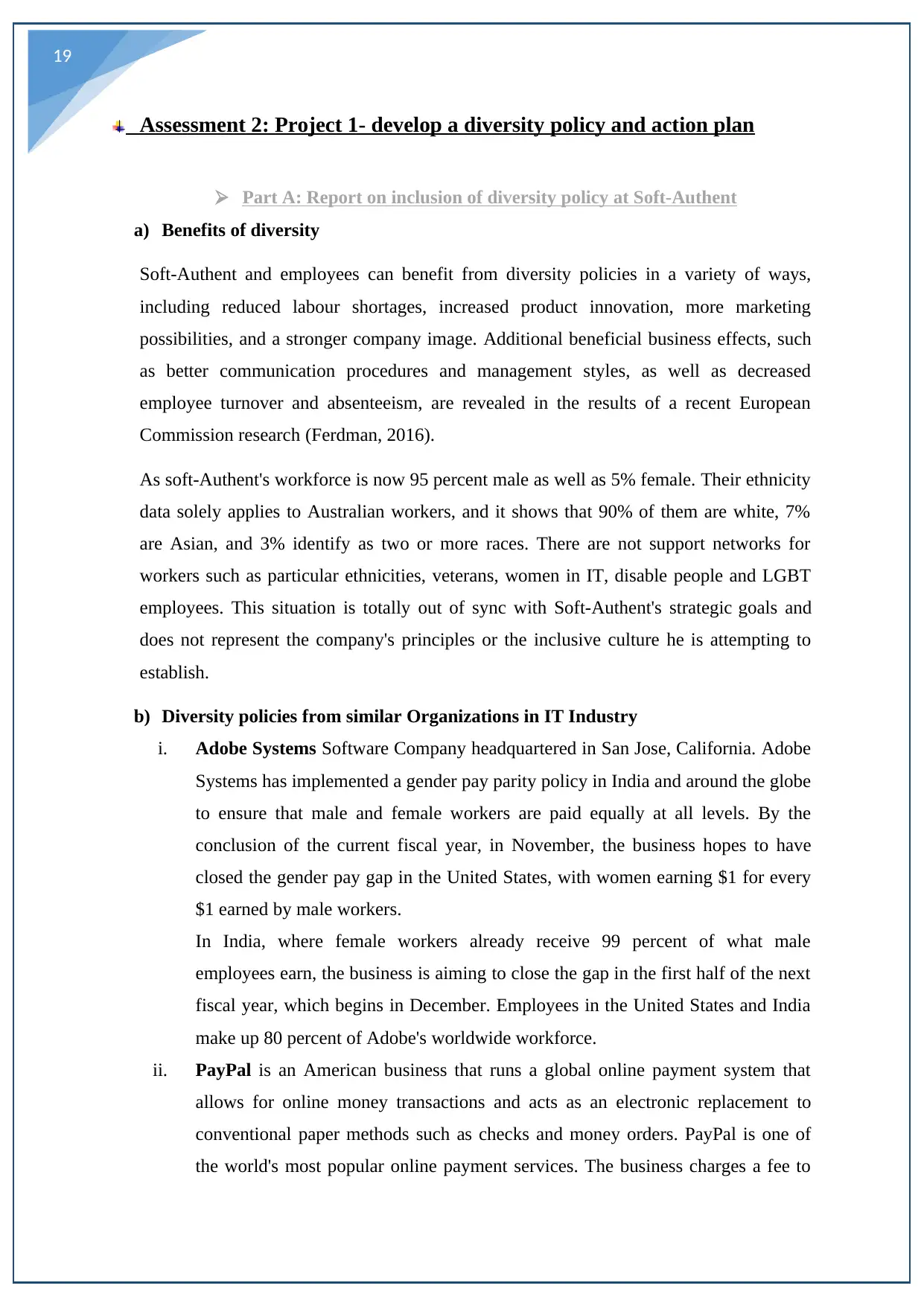
19
Assessment 2: Project 1- develop a diversity policy and action plan
Part A: Report on inclusion of diversity policy at Soft-Authent
a) Benefits of diversity
Soft-Authent and employees can benefit from diversity policies in a variety of ways,
including reduced labour shortages, increased product innovation, more marketing
possibilities, and a stronger company image. Additional beneficial business effects, such
as better communication procedures and management styles, as well as decreased
employee turnover and absenteeism, are revealed in the results of a recent European
Commission research (Ferdman, 2016).
As soft-Authent's workforce is now 95 percent male as well as 5% female. Their ethnicity
data solely applies to Australian workers, and it shows that 90% of them are white, 7%
are Asian, and 3% identify as two or more races. There are not support networks for
workers such as particular ethnicities, veterans, women in IT, disable people and LGBT
employees. This situation is totally out of sync with Soft-Authent's strategic goals and
does not represent the company's principles or the inclusive culture he is attempting to
establish.
b) Diversity policies from similar Organizations in IT Industry
i. Adobe Systems Software Company headquartered in San Jose, California. Adobe
Systems has implemented a gender pay parity policy in India and around the globe
to ensure that male and female workers are paid equally at all levels. By the
conclusion of the current fiscal year, in November, the business hopes to have
closed the gender pay gap in the United States, with women earning $1 for every
$1 earned by male workers.
In India, where female workers already receive 99 percent of what male
employees earn, the business is aiming to close the gap in the first half of the next
fiscal year, which begins in December. Employees in the United States and India
make up 80 percent of Adobe's worldwide workforce.
ii. PayPal is an American business that runs a global online payment system that
allows for online money transactions and acts as an electronic replacement to
conventional paper methods such as checks and money orders. PayPal is one of
the world's most popular online payment services. The business charges a fee to
Assessment 2: Project 1- develop a diversity policy and action plan
Part A: Report on inclusion of diversity policy at Soft-Authent
a) Benefits of diversity
Soft-Authent and employees can benefit from diversity policies in a variety of ways,
including reduced labour shortages, increased product innovation, more marketing
possibilities, and a stronger company image. Additional beneficial business effects, such
as better communication procedures and management styles, as well as decreased
employee turnover and absenteeism, are revealed in the results of a recent European
Commission research (Ferdman, 2016).
As soft-Authent's workforce is now 95 percent male as well as 5% female. Their ethnicity
data solely applies to Australian workers, and it shows that 90% of them are white, 7%
are Asian, and 3% identify as two or more races. There are not support networks for
workers such as particular ethnicities, veterans, women in IT, disable people and LGBT
employees. This situation is totally out of sync with Soft-Authent's strategic goals and
does not represent the company's principles or the inclusive culture he is attempting to
establish.
b) Diversity policies from similar Organizations in IT Industry
i. Adobe Systems Software Company headquartered in San Jose, California. Adobe
Systems has implemented a gender pay parity policy in India and around the globe
to ensure that male and female workers are paid equally at all levels. By the
conclusion of the current fiscal year, in November, the business hopes to have
closed the gender pay gap in the United States, with women earning $1 for every
$1 earned by male workers.
In India, where female workers already receive 99 percent of what male
employees earn, the business is aiming to close the gap in the first half of the next
fiscal year, which begins in December. Employees in the United States and India
make up 80 percent of Adobe's worldwide workforce.
ii. PayPal is an American business that runs a global online payment system that
allows for online money transactions and acts as an electronic replacement to
conventional paper methods such as checks and money orders. PayPal is one of
the world's most popular online payment services. The business charges a fee to
⊘ This is a preview!⊘
Do you want full access?
Subscribe today to unlock all pages.

Trusted by 1+ million students worldwide
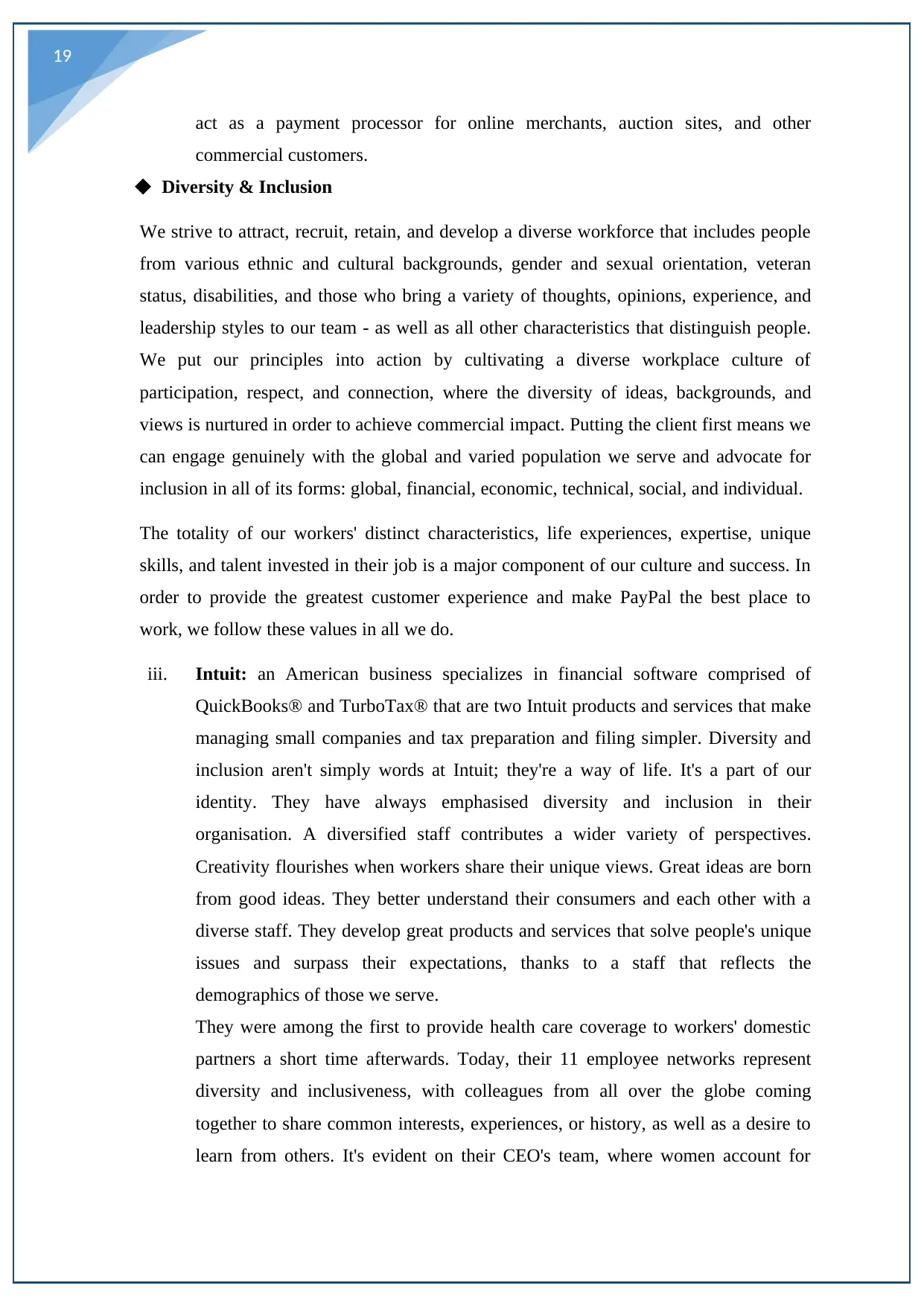
19
act as a payment processor for online merchants, auction sites, and other
commercial customers.
Diversity & Inclusion
We strive to attract, recruit, retain, and develop a diverse workforce that includes people
from various ethnic and cultural backgrounds, gender and sexual orientation, veteran
status, disabilities, and those who bring a variety of thoughts, opinions, experience, and
leadership styles to our team - as well as all other characteristics that distinguish people.
We put our principles into action by cultivating a diverse workplace culture of
participation, respect, and connection, where the diversity of ideas, backgrounds, and
views is nurtured in order to achieve commercial impact. Putting the client first means we
can engage genuinely with the global and varied population we serve and advocate for
inclusion in all of its forms: global, financial, economic, technical, social, and individual.
The totality of our workers' distinct characteristics, life experiences, expertise, unique
skills, and talent invested in their job is a major component of our culture and success. In
order to provide the greatest customer experience and make PayPal the best place to
work, we follow these values in all we do.
iii. Intuit: an American business specializes in financial software comprised of
QuickBooks® and TurboTax® that are two Intuit products and services that make
managing small companies and tax preparation and filing simpler. Diversity and
inclusion aren't simply words at Intuit; they're a way of life. It's a part of our
identity. They have always emphasised diversity and inclusion in their
organisation. A diversified staff contributes a wider variety of perspectives.
Creativity flourishes when workers share their unique views. Great ideas are born
from good ideas. They better understand their consumers and each other with a
diverse staff. They develop great products and services that solve people's unique
issues and surpass their expectations, thanks to a staff that reflects the
demographics of those we serve.
They were among the first to provide health care coverage to workers' domestic
partners a short time afterwards. Today, their 11 employee networks represent
diversity and inclusiveness, with colleagues from all over the globe coming
together to share common interests, experiences, or history, as well as a desire to
learn from others. It's evident on their CEO's team, where women account for
act as a payment processor for online merchants, auction sites, and other
commercial customers.
Diversity & Inclusion
We strive to attract, recruit, retain, and develop a diverse workforce that includes people
from various ethnic and cultural backgrounds, gender and sexual orientation, veteran
status, disabilities, and those who bring a variety of thoughts, opinions, experience, and
leadership styles to our team - as well as all other characteristics that distinguish people.
We put our principles into action by cultivating a diverse workplace culture of
participation, respect, and connection, where the diversity of ideas, backgrounds, and
views is nurtured in order to achieve commercial impact. Putting the client first means we
can engage genuinely with the global and varied population we serve and advocate for
inclusion in all of its forms: global, financial, economic, technical, social, and individual.
The totality of our workers' distinct characteristics, life experiences, expertise, unique
skills, and talent invested in their job is a major component of our culture and success. In
order to provide the greatest customer experience and make PayPal the best place to
work, we follow these values in all we do.
iii. Intuit: an American business specializes in financial software comprised of
QuickBooks® and TurboTax® that are two Intuit products and services that make
managing small companies and tax preparation and filing simpler. Diversity and
inclusion aren't simply words at Intuit; they're a way of life. It's a part of our
identity. They have always emphasised diversity and inclusion in their
organisation. A diversified staff contributes a wider variety of perspectives.
Creativity flourishes when workers share their unique views. Great ideas are born
from good ideas. They better understand their consumers and each other with a
diverse staff. They develop great products and services that solve people's unique
issues and surpass their expectations, thanks to a staff that reflects the
demographics of those we serve.
They were among the first to provide health care coverage to workers' domestic
partners a short time afterwards. Today, their 11 employee networks represent
diversity and inclusiveness, with colleagues from all over the globe coming
together to share common interests, experiences, or history, as well as a desire to
learn from others. It's evident on their CEO's team, where women account for
Paraphrase This Document
Need a fresh take? Get an instant paraphrase of this document with our AI Paraphraser
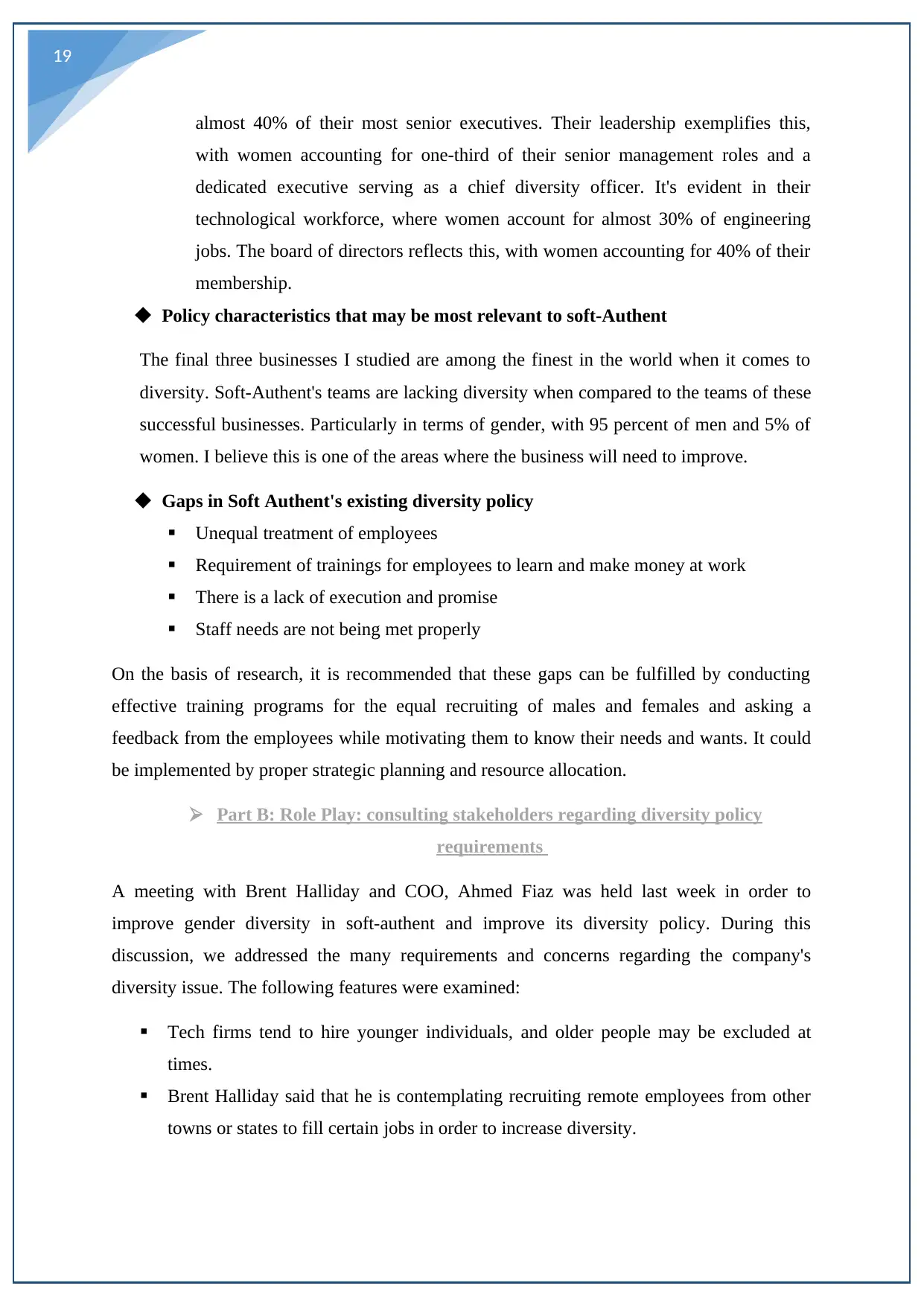
19
almost 40% of their most senior executives. Their leadership exemplifies this,
with women accounting for one-third of their senior management roles and a
dedicated executive serving as a chief diversity officer. It's evident in their
technological workforce, where women account for almost 30% of engineering
jobs. The board of directors reflects this, with women accounting for 40% of their
membership.
Policy characteristics that may be most relevant to soft-Authent
The final three businesses I studied are among the finest in the world when it comes to
diversity. Soft-Authent's teams are lacking diversity when compared to the teams of these
successful businesses. Particularly in terms of gender, with 95 percent of men and 5% of
women. I believe this is one of the areas where the business will need to improve.
Gaps in Soft Authent's existing diversity policy
Unequal treatment of employees
Requirement of trainings for employees to learn and make money at work
There is a lack of execution and promise
Staff needs are not being met properly
On the basis of research, it is recommended that these gaps can be fulfilled by conducting
effective training programs for the equal recruiting of males and females and asking a
feedback from the employees while motivating them to know their needs and wants. It could
be implemented by proper strategic planning and resource allocation.
Part B: Role Play: consulting stakeholders regarding diversity policy
requirements
A meeting with Brent Halliday and COO, Ahmed Fiaz was held last week in order to
improve gender diversity in soft-authent and improve its diversity policy. During this
discussion, we addressed the many requirements and concerns regarding the company's
diversity issue. The following features were examined:
Tech firms tend to hire younger individuals, and older people may be excluded at
times.
Brent Halliday said that he is contemplating recruiting remote employees from other
towns or states to fill certain jobs in order to increase diversity.
almost 40% of their most senior executives. Their leadership exemplifies this,
with women accounting for one-third of their senior management roles and a
dedicated executive serving as a chief diversity officer. It's evident in their
technological workforce, where women account for almost 30% of engineering
jobs. The board of directors reflects this, with women accounting for 40% of their
membership.
Policy characteristics that may be most relevant to soft-Authent
The final three businesses I studied are among the finest in the world when it comes to
diversity. Soft-Authent's teams are lacking diversity when compared to the teams of these
successful businesses. Particularly in terms of gender, with 95 percent of men and 5% of
women. I believe this is one of the areas where the business will need to improve.
Gaps in Soft Authent's existing diversity policy
Unequal treatment of employees
Requirement of trainings for employees to learn and make money at work
There is a lack of execution and promise
Staff needs are not being met properly
On the basis of research, it is recommended that these gaps can be fulfilled by conducting
effective training programs for the equal recruiting of males and females and asking a
feedback from the employees while motivating them to know their needs and wants. It could
be implemented by proper strategic planning and resource allocation.
Part B: Role Play: consulting stakeholders regarding diversity policy
requirements
A meeting with Brent Halliday and COO, Ahmed Fiaz was held last week in order to
improve gender diversity in soft-authent and improve its diversity policy. During this
discussion, we addressed the many requirements and concerns regarding the company's
diversity issue. The following features were examined:
Tech firms tend to hire younger individuals, and older people may be excluded at
times.
Brent Halliday said that he is contemplating recruiting remote employees from other
towns or states to fill certain jobs in order to increase diversity.
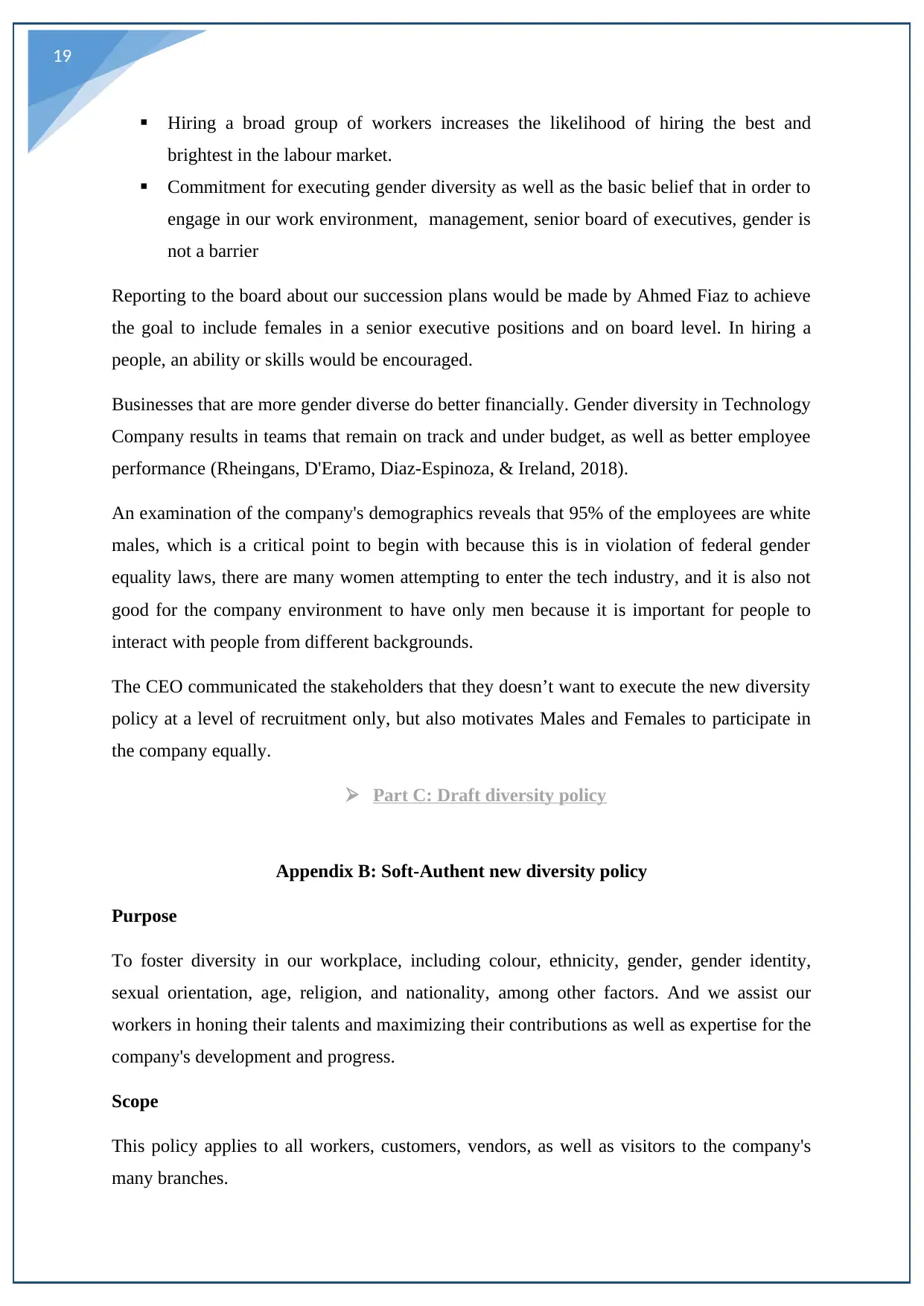
19
Hiring a broad group of workers increases the likelihood of hiring the best and
brightest in the labour market.
Commitment for executing gender diversity as well as the basic belief that in order to
engage in our work environment, management, senior board of executives, gender is
not a barrier
Reporting to the board about our succession plans would be made by Ahmed Fiaz to achieve
the goal to include females in a senior executive positions and on board level. In hiring a
people, an ability or skills would be encouraged.
Businesses that are more gender diverse do better financially. Gender diversity in Technology
Company results in teams that remain on track and under budget, as well as better employee
performance (Rheingans, D'Eramo, Diaz-Espinoza, & Ireland, 2018).
An examination of the company's demographics reveals that 95% of the employees are white
males, which is a critical point to begin with because this is in violation of federal gender
equality laws, there are many women attempting to enter the tech industry, and it is also not
good for the company environment to have only men because it is important for people to
interact with people from different backgrounds.
The CEO communicated the stakeholders that they doesn’t want to execute the new diversity
policy at a level of recruitment only, but also motivates Males and Females to participate in
the company equally.
Part C: Draft diversity policy
Appendix B: Soft-Authent new diversity policy
Purpose
To foster diversity in our workplace, including colour, ethnicity, gender, gender identity,
sexual orientation, age, religion, and nationality, among other factors. And we assist our
workers in honing their talents and maximizing their contributions as well as expertise for the
company's development and progress.
Scope
This policy applies to all workers, customers, vendors, as well as visitors to the company's
many branches.
Hiring a broad group of workers increases the likelihood of hiring the best and
brightest in the labour market.
Commitment for executing gender diversity as well as the basic belief that in order to
engage in our work environment, management, senior board of executives, gender is
not a barrier
Reporting to the board about our succession plans would be made by Ahmed Fiaz to achieve
the goal to include females in a senior executive positions and on board level. In hiring a
people, an ability or skills would be encouraged.
Businesses that are more gender diverse do better financially. Gender diversity in Technology
Company results in teams that remain on track and under budget, as well as better employee
performance (Rheingans, D'Eramo, Diaz-Espinoza, & Ireland, 2018).
An examination of the company's demographics reveals that 95% of the employees are white
males, which is a critical point to begin with because this is in violation of federal gender
equality laws, there are many women attempting to enter the tech industry, and it is also not
good for the company environment to have only men because it is important for people to
interact with people from different backgrounds.
The CEO communicated the stakeholders that they doesn’t want to execute the new diversity
policy at a level of recruitment only, but also motivates Males and Females to participate in
the company equally.
Part C: Draft diversity policy
Appendix B: Soft-Authent new diversity policy
Purpose
To foster diversity in our workplace, including colour, ethnicity, gender, gender identity,
sexual orientation, age, religion, and nationality, among other factors. And we assist our
workers in honing their talents and maximizing their contributions as well as expertise for the
company's development and progress.
Scope
This policy applies to all workers, customers, vendors, as well as visitors to the company's
many branches.
⊘ This is a preview!⊘
Do you want full access?
Subscribe today to unlock all pages.

Trusted by 1+ million students worldwide
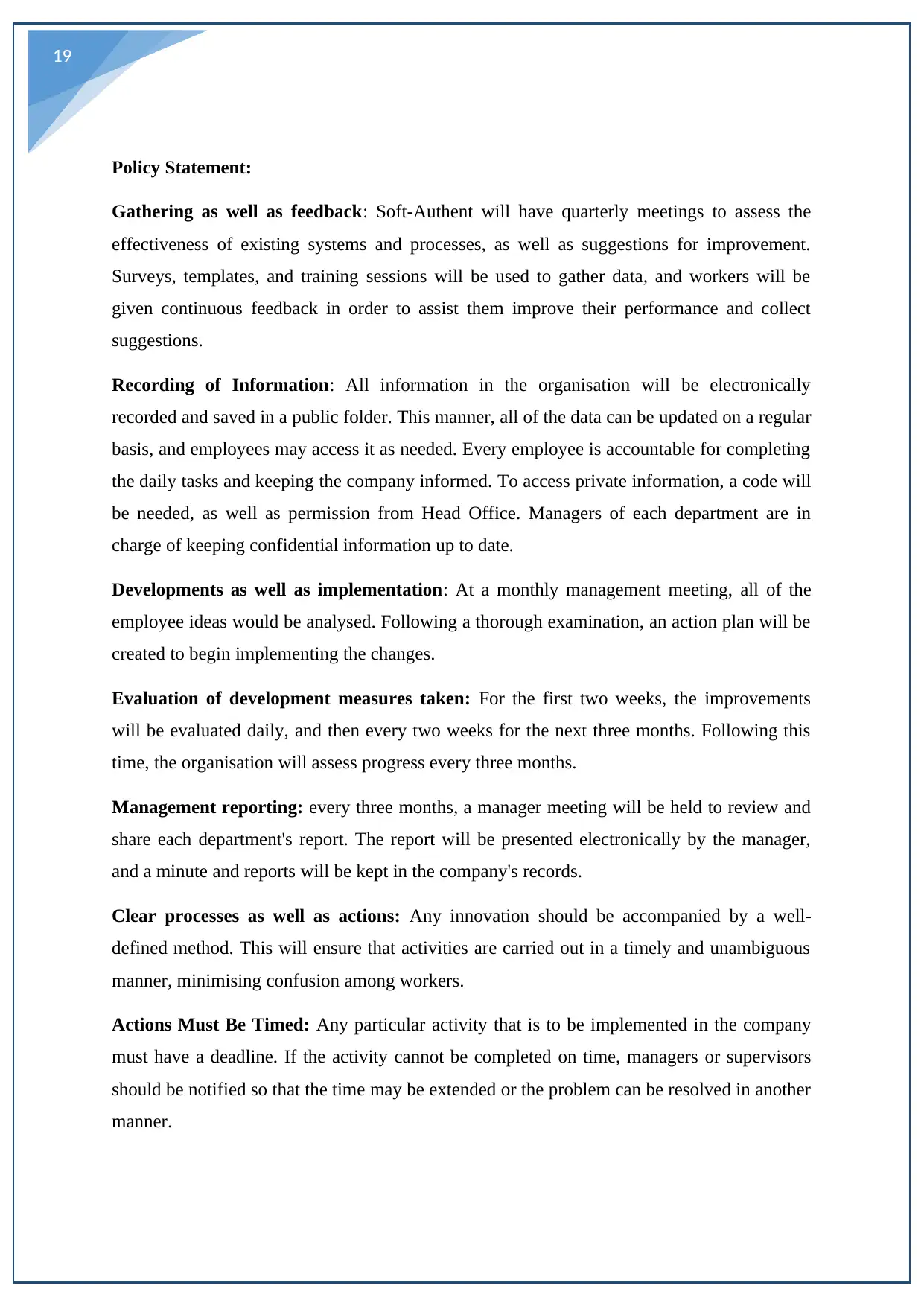
19
Policy Statement:
Gathering as well as feedback: Soft-Authent will have quarterly meetings to assess the
effectiveness of existing systems and processes, as well as suggestions for improvement.
Surveys, templates, and training sessions will be used to gather data, and workers will be
given continuous feedback in order to assist them improve their performance and collect
suggestions.
Recording of Information: All information in the organisation will be electronically
recorded and saved in a public folder. This manner, all of the data can be updated on a regular
basis, and employees may access it as needed. Every employee is accountable for completing
the daily tasks and keeping the company informed. To access private information, a code will
be needed, as well as permission from Head Office. Managers of each department are in
charge of keeping confidential information up to date.
Developments as well as implementation: At a monthly management meeting, all of the
employee ideas would be analysed. Following a thorough examination, an action plan will be
created to begin implementing the changes.
Evaluation of development measures taken: For the first two weeks, the improvements
will be evaluated daily, and then every two weeks for the next three months. Following this
time, the organisation will assess progress every three months.
Management reporting: every three months, a manager meeting will be held to review and
share each department's report. The report will be presented electronically by the manager,
and a minute and reports will be kept in the company's records.
Clear processes as well as actions: Any innovation should be accompanied by a well-
defined method. This will ensure that activities are carried out in a timely and unambiguous
manner, minimising confusion among workers.
Actions Must Be Timed: Any particular activity that is to be implemented in the company
must have a deadline. If the activity cannot be completed on time, managers or supervisors
should be notified so that the time may be extended or the problem can be resolved in another
manner.
Policy Statement:
Gathering as well as feedback: Soft-Authent will have quarterly meetings to assess the
effectiveness of existing systems and processes, as well as suggestions for improvement.
Surveys, templates, and training sessions will be used to gather data, and workers will be
given continuous feedback in order to assist them improve their performance and collect
suggestions.
Recording of Information: All information in the organisation will be electronically
recorded and saved in a public folder. This manner, all of the data can be updated on a regular
basis, and employees may access it as needed. Every employee is accountable for completing
the daily tasks and keeping the company informed. To access private information, a code will
be needed, as well as permission from Head Office. Managers of each department are in
charge of keeping confidential information up to date.
Developments as well as implementation: At a monthly management meeting, all of the
employee ideas would be analysed. Following a thorough examination, an action plan will be
created to begin implementing the changes.
Evaluation of development measures taken: For the first two weeks, the improvements
will be evaluated daily, and then every two weeks for the next three months. Following this
time, the organisation will assess progress every three months.
Management reporting: every three months, a manager meeting will be held to review and
share each department's report. The report will be presented electronically by the manager,
and a minute and reports will be kept in the company's records.
Clear processes as well as actions: Any innovation should be accompanied by a well-
defined method. This will ensure that activities are carried out in a timely and unambiguous
manner, minimising confusion among workers.
Actions Must Be Timed: Any particular activity that is to be implemented in the company
must have a deadline. If the activity cannot be completed on time, managers or supervisors
should be notified so that the time may be extended or the problem can be resolved in another
manner.
Paraphrase This Document
Need a fresh take? Get an instant paraphrase of this document with our AI Paraphraser
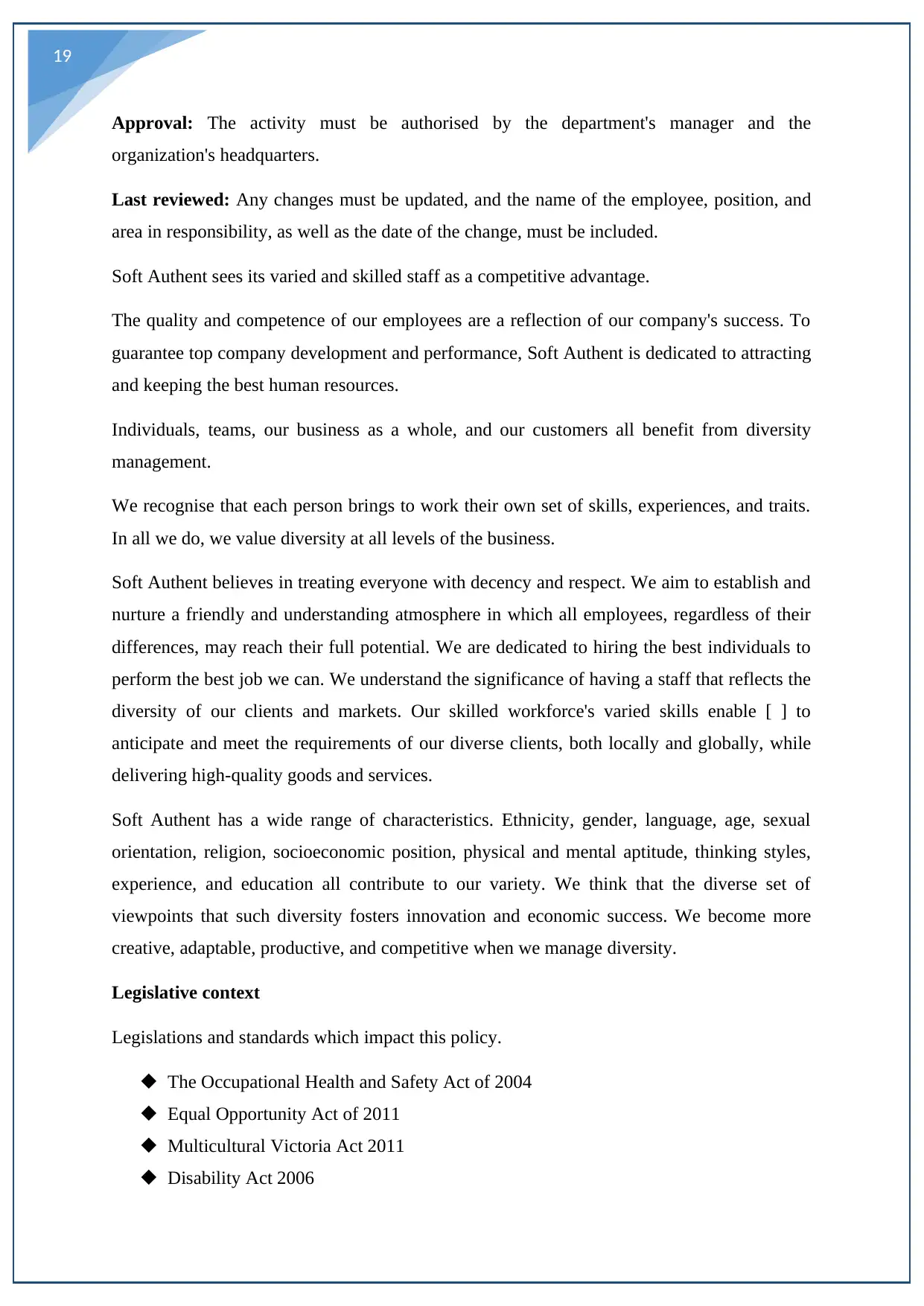
19
Approval: The activity must be authorised by the department's manager and the
organization's headquarters.
Last reviewed: Any changes must be updated, and the name of the employee, position, and
area in responsibility, as well as the date of the change, must be included.
Soft Authent sees its varied and skilled staff as a competitive advantage.
The quality and competence of our employees are a reflection of our company's success. To
guarantee top company development and performance, Soft Authent is dedicated to attracting
and keeping the best human resources.
Individuals, teams, our business as a whole, and our customers all benefit from diversity
management.
We recognise that each person brings to work their own set of skills, experiences, and traits.
In all we do, we value diversity at all levels of the business.
Soft Authent believes in treating everyone with decency and respect. We aim to establish and
nurture a friendly and understanding atmosphere in which all employees, regardless of their
differences, may reach their full potential. We are dedicated to hiring the best individuals to
perform the best job we can. We understand the significance of having a staff that reflects the
diversity of our clients and markets. Our skilled workforce's varied skills enable [ ] to
anticipate and meet the requirements of our diverse clients, both locally and globally, while
delivering high-quality goods and services.
Soft Authent has a wide range of characteristics. Ethnicity, gender, language, age, sexual
orientation, religion, socioeconomic position, physical and mental aptitude, thinking styles,
experience, and education all contribute to our variety. We think that the diverse set of
viewpoints that such diversity fosters innovation and economic success. We become more
creative, adaptable, productive, and competitive when we manage diversity.
Legislative context
Legislations and standards which impact this policy.
The Occupational Health and Safety Act of 2004
Equal Opportunity Act of 2011
Multicultural Victoria Act 2011
Disability Act 2006
Approval: The activity must be authorised by the department's manager and the
organization's headquarters.
Last reviewed: Any changes must be updated, and the name of the employee, position, and
area in responsibility, as well as the date of the change, must be included.
Soft Authent sees its varied and skilled staff as a competitive advantage.
The quality and competence of our employees are a reflection of our company's success. To
guarantee top company development and performance, Soft Authent is dedicated to attracting
and keeping the best human resources.
Individuals, teams, our business as a whole, and our customers all benefit from diversity
management.
We recognise that each person brings to work their own set of skills, experiences, and traits.
In all we do, we value diversity at all levels of the business.
Soft Authent believes in treating everyone with decency and respect. We aim to establish and
nurture a friendly and understanding atmosphere in which all employees, regardless of their
differences, may reach their full potential. We are dedicated to hiring the best individuals to
perform the best job we can. We understand the significance of having a staff that reflects the
diversity of our clients and markets. Our skilled workforce's varied skills enable [ ] to
anticipate and meet the requirements of our diverse clients, both locally and globally, while
delivering high-quality goods and services.
Soft Authent has a wide range of characteristics. Ethnicity, gender, language, age, sexual
orientation, religion, socioeconomic position, physical and mental aptitude, thinking styles,
experience, and education all contribute to our variety. We think that the diverse set of
viewpoints that such diversity fosters innovation and economic success. We become more
creative, adaptable, productive, and competitive when we manage diversity.
Legislative context
Legislations and standards which impact this policy.
The Occupational Health and Safety Act of 2004
Equal Opportunity Act of 2011
Multicultural Victoria Act 2011
Disability Act 2006
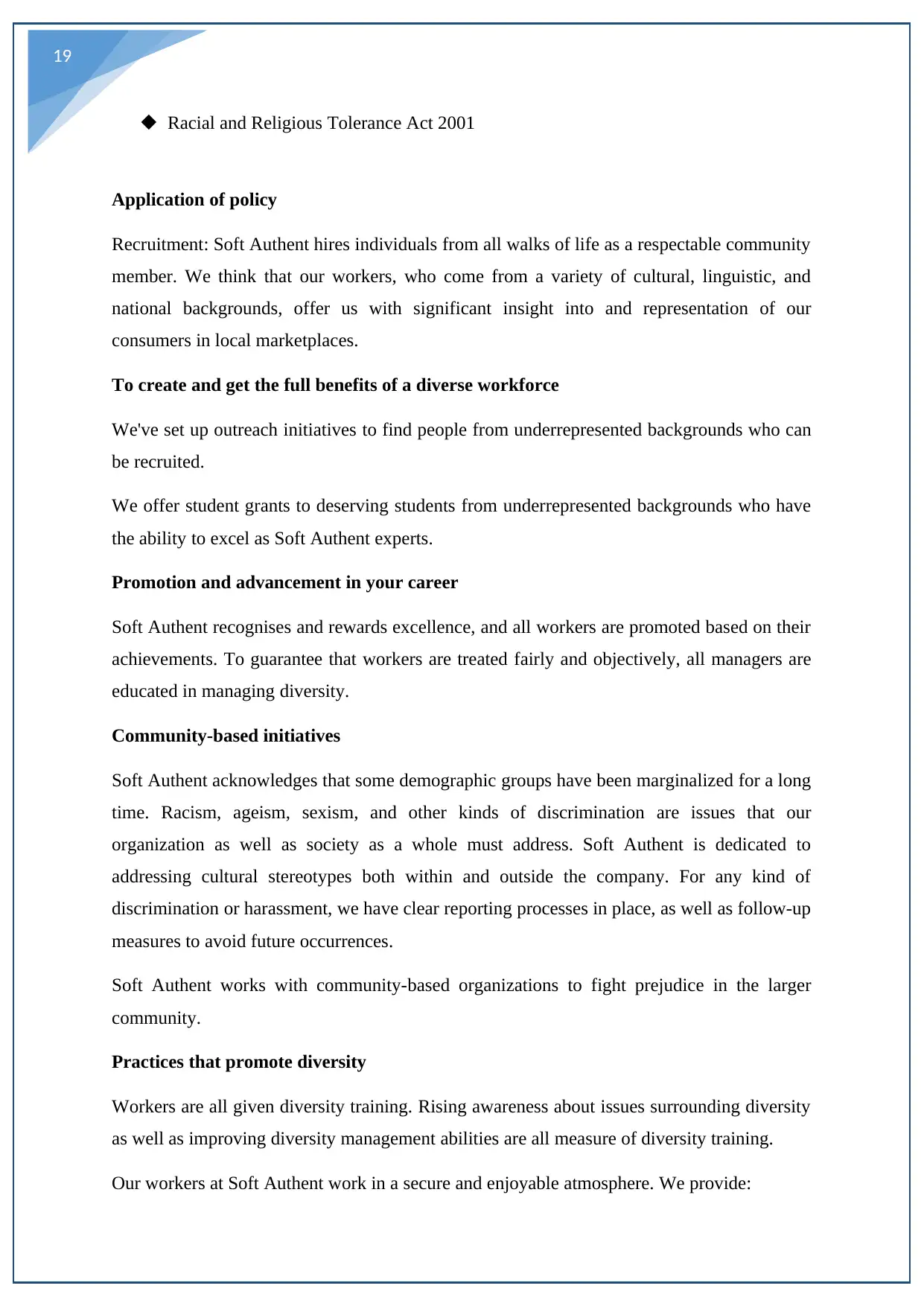
19
Racial and Religious Tolerance Act 2001
Application of policy
Recruitment: Soft Authent hires individuals from all walks of life as a respectable community
member. We think that our workers, who come from a variety of cultural, linguistic, and
national backgrounds, offer us with significant insight into and representation of our
consumers in local marketplaces.
To create and get the full benefits of a diverse workforce
We've set up outreach initiatives to find people from underrepresented backgrounds who can
be recruited.
We offer student grants to deserving students from underrepresented backgrounds who have
the ability to excel as Soft Authent experts.
Promotion and advancement in your career
Soft Authent recognises and rewards excellence, and all workers are promoted based on their
achievements. To guarantee that workers are treated fairly and objectively, all managers are
educated in managing diversity.
Community-based initiatives
Soft Authent acknowledges that some demographic groups have been marginalized for a long
time. Racism, ageism, sexism, and other kinds of discrimination are issues that our
organization as well as society as a whole must address. Soft Authent is dedicated to
addressing cultural stereotypes both within and outside the company. For any kind of
discrimination or harassment, we have clear reporting processes in place, as well as follow-up
measures to avoid future occurrences.
Soft Authent works with community-based organizations to fight prejudice in the larger
community.
Practices that promote diversity
Workers are all given diversity training. Rising awareness about issues surrounding diversity
as well as improving diversity management abilities are all measure of diversity training.
Our workers at Soft Authent work in a secure and enjoyable atmosphere. We provide:
Racial and Religious Tolerance Act 2001
Application of policy
Recruitment: Soft Authent hires individuals from all walks of life as a respectable community
member. We think that our workers, who come from a variety of cultural, linguistic, and
national backgrounds, offer us with significant insight into and representation of our
consumers in local marketplaces.
To create and get the full benefits of a diverse workforce
We've set up outreach initiatives to find people from underrepresented backgrounds who can
be recruited.
We offer student grants to deserving students from underrepresented backgrounds who have
the ability to excel as Soft Authent experts.
Promotion and advancement in your career
Soft Authent recognises and rewards excellence, and all workers are promoted based on their
achievements. To guarantee that workers are treated fairly and objectively, all managers are
educated in managing diversity.
Community-based initiatives
Soft Authent acknowledges that some demographic groups have been marginalized for a long
time. Racism, ageism, sexism, and other kinds of discrimination are issues that our
organization as well as society as a whole must address. Soft Authent is dedicated to
addressing cultural stereotypes both within and outside the company. For any kind of
discrimination or harassment, we have clear reporting processes in place, as well as follow-up
measures to avoid future occurrences.
Soft Authent works with community-based organizations to fight prejudice in the larger
community.
Practices that promote diversity
Workers are all given diversity training. Rising awareness about issues surrounding diversity
as well as improving diversity management abilities are all measure of diversity training.
Our workers at Soft Authent work in a secure and enjoyable atmosphere. We provide:
⊘ This is a preview!⊘
Do you want full access?
Subscribe today to unlock all pages.

Trusted by 1+ million students worldwide
1 out of 20
Related Documents
Your All-in-One AI-Powered Toolkit for Academic Success.
+13062052269
info@desklib.com
Available 24*7 on WhatsApp / Email
![[object Object]](/_next/static/media/star-bottom.7253800d.svg)
Unlock your academic potential
Copyright © 2020–2025 A2Z Services. All Rights Reserved. Developed and managed by ZUCOL.





